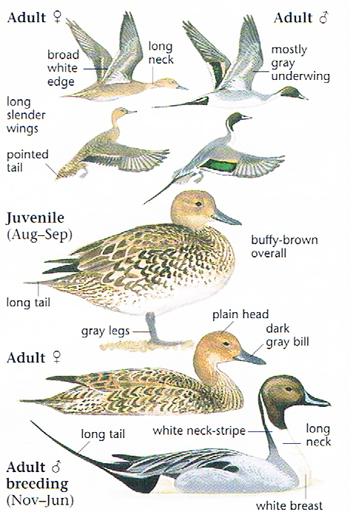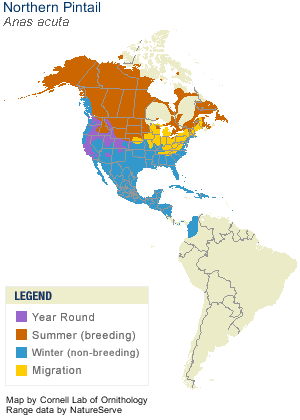|
|
|
 |
Northern Pintail
|
| Anas acuta | |
Slim and long-necked, the Northern Pintail has a distinctive silhouette. The male is easy to identify by his striking markings and long tail, but even the female can be recognized by her graceful, long-necked shape.
Interesting Information
-
Like the Mallard, the Northern Pintail breeds in a variety of habitats all across northern North America and Eurasia. Also like the Mallard, island populations have splintered off and evolved into separate species. Two closely related forms can be found on Crozet and Kerguelen islands in the very southern Indian Ocean, known as Eaton's Pintail (Anas eatoni).
-
The Northern Pintail is among the earliest nesting ducks in North America, beginning shortly after ice-out in many northern areas.
Description
Adult Description
-
Size: 51-76 cm (20-30 in)
-
Weight: 500-1450 g (17.65-51.19 ounces)
-
Medium-sized duck.
-
Long, thin neck.
-
Pointed tail, extremely long in males.
-
Male with white chest, white stripe up neck, and dark reddish brown head.
-
Long, narrow wings.
Sex Differences
Male boldly patterned with white chest and long tail; female dull brown.
Female Crown and face tan. Chin whitish. Back and rump brown with lighter edges to feathers. Upper breast buff or tan. Lower breast and belly white. Tail pointed, with central tail feathers longest. Rear of wing (speculum) bronzy greenish with black band and white rear edge. Bill dull black, occasionally with bluish stripes. Eyes dark brown. Legs bluish gray.
Male
Breeding (Alternate) Plumage:
Chocolate-brown head. White neck and underparts, white extending up back of neck in thin line. Very long black central tail feathers. Black rear end bordered by yellowish tan patch. Sides and upper back gray. Lower back feathers long and black with pale edges. Rear of wing (speculum) bronzy greenish with black band and white rear edge. Bill black with bluish gray stripes. Eyes dark brown. Legs gray.
Eclipse (Basic) Plumage
Duller. Overall brownish. Head, throat, and neck medium brownish with fine dark streaks. Upperparts brownish to grayish with broad dark barring. Central tail feathers brown and long, but much shorter and wider than in breeding plumage. Bill black with bluish gray stripes. Eyes dark brown. Legs gray.
Immature
Similar to adult female.

Photo taken from: The Sibley Field Guide by David Allen Sibley

© 2003 Cornell Lab of Ornithology
|
Habitat |
|
Nests in open country with shallow, seasonal wetlands and low vegetation. Winters in wide variety of shallow inland freshwater and intertidal habitats. |
|
Behavior |
|
Picks food from surface of ground. Dabbles, filter-feeds at surface of water, tips-up in shallow water. |
|
Food |
|
Grain, seeds, weeds, aquatic insects, crustaceans, and snails. |
Taxonomy
| Kingdom: | Animalia |
| Phylum: | Chordata |
| Subphylum: | Vertebrata |
| Class: | Aves |
| Order: | Anseriformes |
| Family: | Anatidae |
| Subfamily: | Anserinae |
| Genus: | Anas |
| Species: | Anas acuta |
Similar Species |
No other female dabbling duck has such a long thin neck and a plain tan face. |
|
Bird Sound |
|
Male makes wheezy mewing notes and a whistle. Female quacks. |
|
Eggs look like this |
|
Photo taken from: ARCTOS Collaborative Collection Management Solution |
Videos
Northern Pintail
Male and Female






















